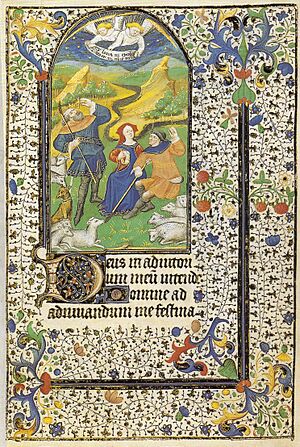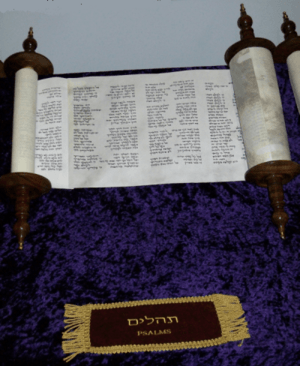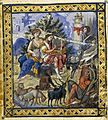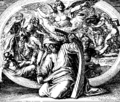Psalms facts for kids
The Psalms are a special collection of 150 poems found in the Bible. These poems were originally written in Hebrew. The word "Psalms" comes from a Greek word that means "songs sung with stringed instruments."
In Hebrew, the book is called Tehillim, which means "praises." Many people believe that King David wrote a lot of these poems to God. One of the most famous Psalms is Psalm 23, which begins, "The LORD is my shepherd." This Psalm is often read at funerals.
The 150 Psalms are considered holy by Jews, Protestants, and Catholics. However, the Eastern Orthodox Church also includes an extra poem called Psalm 151 in their holy books.
What Does "Psalms" Mean?
The names "Psalms" and "Psalter" come from an old Greek translation of the Old Testament called the Septuagint. These words first referred to musical instruments with strings, like the harp or lyre. Later, they were used for songs sung along with these instruments.
The original Hebrew name for the book is Tehillim. This means "praises." Even though many Psalms are praises, some are also tephillot, which means "prayers." One early part of the book was even called "the prayers of David son of Jesse."
What Are Psalms Like?
The Book of Psalms is a collection of poetry. Even though many are prayers, not all prayers in the Old Testament are poems. The Psalms are full of interesting pictures and comparisons. They use metaphors to describe things.
The Hebrew text often plays with words. It repeats words or uses words with similar meanings to make descriptions richer. Important words in a Psalm often show what the main message or theme of that prayer or song is.
Images for kids
-
David is shown writing the Psalms in this image from the Paris Psalter, made in the 10th century.
-
This 1860 woodcut by Julius Schnorr von Carolsfeld shows David offering a psalm to ask for help.
-
David is shown offering a psalm of sorrow in this 1860 woodcut by Julius Schnorr von Carolsfeld.
-
Psalm 11 from the 9th-century Utrecht Psalter. The pictures in this book often show the text very clearly.
See also
 In Spanish: Libro de los salmos para niños
In Spanish: Libro de los salmos para niños








